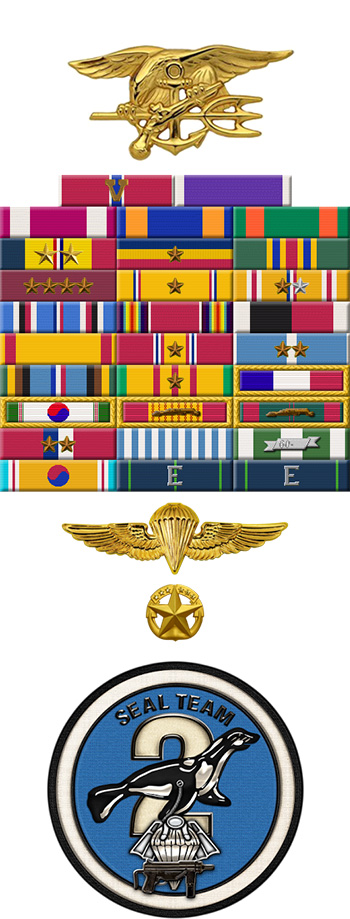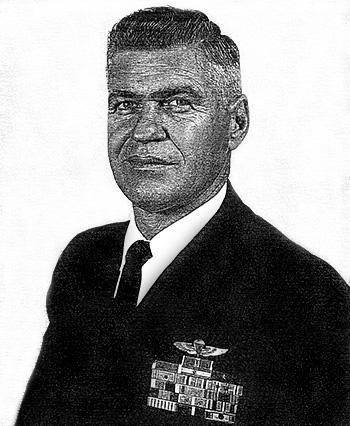
|
Roy H. Boehm |
 |
|||
| Rank, Service | ||||
Lieutenant Commander O-4, U.S. Navy |
||||
| Veteran of: | ||||
|
||||
| Tribute: | ||||
Roy Boehm was born on April 9, 1924, in Brooklyn, New York. He enlisted in the U.S. Navy on April 10, 1941, and competed basic training at NTS Norfolk, Virginia, in June 1941. His first assignment was as a Seaman and Boatswain's Mate aboard the submarine tender USS Griffin (AS-13) from July to September 1941, followed by service aboard the repair ship USS Alcor (AR-10) from September 1941 to March 1942. BM3 Boehm served aboard the destroyer USS Duncan (DD-485) from April 1942 until that ship was sunk in October 1942, and then aboard the heavy cruiser USS Salt Lake City (CA-25) from October to November 1942. His next assignment was aboard the light cruiser USS Boise (CL-47) from November 1942 to March 1943, followed by the destroyer USS Floyd Bennett (DD-473) from March 1943 to October 1944. BM2 Boehm's final assignment during World War II was aboard the cargo ship USS Bycyrus Victory (AK-234) from November 1944 to November 1945. During World War II, Petty Officer Boehm participated in the Battle of Guadalcanal (September-October 1942), the Battle of Cape Esperance (11-12 October 1942), the Bougainville landings (1 November 1943 and 15 February 1944), bombardment of New Ireland (18 February 1944), bombardment of Rabaul, New Britain (29 February 1944), Invasion of Saipan (14 June-1 July 1944), Invasion of Guam (2-16 August 1944), and the Invasion of Peleliu (6-25 September 1944). He next served aboard the aircraft carrier USS Franklin D. Roosevelt (CVB-42) from January to November 1946, and then was a patient at the Portsmouth Naval Hospital in Portsmouth, Virginia, from November 1946 until he received an honorable discharge from the Navy in April 1947. BM2 Boehm reenlisted in the U.S. Navy in June 1947, and served aboard the destroyer USS Furse (DD-882) from June 1947 to March 1948. He served at the U.S. Naval Mine Countermeasure Station at Panama City, Florida, from May 1948 to May 1950, and then aboard the light cruiser USS Worcester (CL-144) from May 1950 to October 1951. During this time, BM1 Boehm was aboard the Worcester during her participation in the Korean War from August to October 1950. He next attended the Deep Sea Diving School at Washington, D.C., from October 1951 to April 1952, followed by service aboard the submarine rescue ship USS Penguin (ASR-12) from June 1952 to May 1954. BM1 Boehm attended Underwater Demolition Team Replacement training at NAB Little Creek, Virginia, from August to November 1954, and then served with UDT-21 at NAB Little Creek from November 1954 to July 1958. He entered Officer Candidate School in July 1958, and was commissioned an Ensign in the Navy in September 1958. His next assignment was aboard the fleet ocean tug USS Papago (ATF-160) from September 1958 to December 1960, followed by service back with UDT-21 at NAB Little Creek from January 1961 to January 1962. LT Boehm served as the first Commanding Officer of SEAL Team TWO at NAB Little Creek from January to November 1962, and then served with Service Squadron EIGHT from November 1962 to August 1963. His next assignment was as a member of the Navy Advisory Group with U.S. Military Assistance Command, Vietnam, in South Vietnam from November 1963 to July 1964, and he was then a patient at Clark AFB in the Philippines and then at the U.S. Naval Hospital at Bethesda, Maryland, from July to October 1964. LCDR Boehm served as an instructor at the Naval Amphibious School at NAB Coronado, California, from October 1964 to September 1966, and then as Director of River Patrol Training with the Naval Inshore Operations Training Center at Mare Island, California, from September 1966 to July 1969. His final assignment was with the Naval Amphibious School at NAB Little Creek from July 1969 until his retirement from the Navy on August 1, 1971. Roy Boehm died on December 30, 2008. |
||||
|
||||

